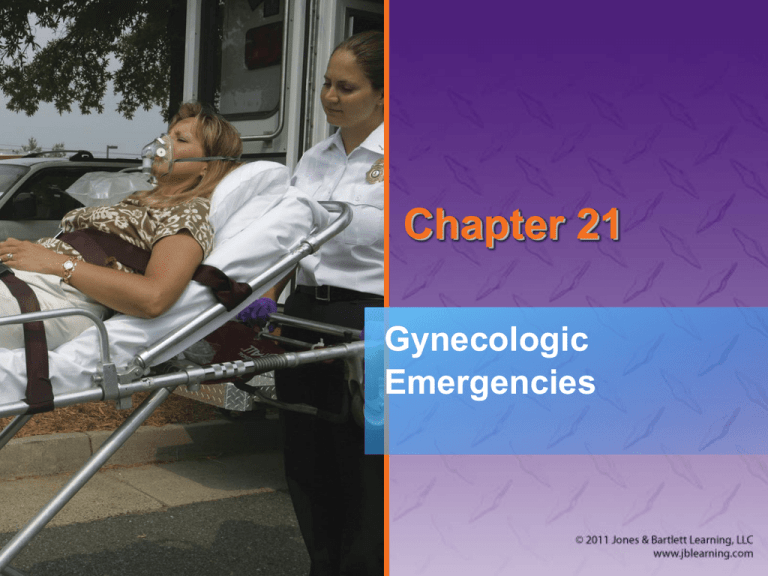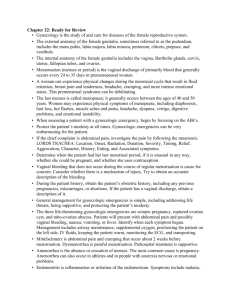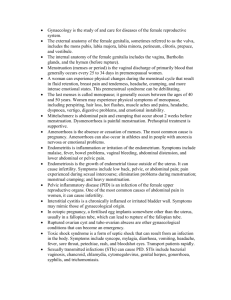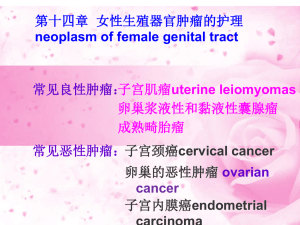
Chapter 21
Gynecologic
Emergencies
Introduction
• Women are uniquely designed to conceive
and give birth.
– Women are susceptible to problems that do not
occur in men.
Anatomy and Physiology (1 of 8)
• Ovaries are a primary female reproductive
organ.
– Lie on each side of lower abdomen
– Produce ovum (egg)
• Each ovary produces an ovum in alternating
months.
– Each month one ovum is released into fallopian
tubes (ovulation).
Anatomy and Physiology (2 of 8)
• Some women experience cramping during
ovulation.
• Fallopian tubes connect each ovary with the
uterus.
– Fallopian tubes are primary location for
fertilization.
• Uterus is a muscular organ where fetus
grows.
Anatomy and Physiology (3 of 8)
• Narrowest part of uterus is cervix.
– Cervix opens into the vagina.
• Vagina is outermost cavity of woman’s
reproductive system.
– Forms the lower part of birth canal.
– Sperm is deposited from the male penis, passes
through cervix to uterus, and up the fallopian
tubes.
Anatomy and Physiology (4 of 8)
• If fertilization does not occur within about 14
days of ovulation:
– The lining of the uterus begins to separate, and
menstruation occurs for about a week.
• Process of menstruation is controlled by
female hormones.
Anatomy and Physiology (5 of 8)
Anatomy and Physiology (6 of 8)
• Female genitalia
– Vaginal opening
– Urethra
– Labia majora and labia minora
– Clitoris
• Perineum is area of skin between vagina
and anus.
Anatomy and Physiology (7 of 8)
Anatomy and Physiology (8 of 8)
• Puberty is when ovulation and menstruation
begin.
– Onset of menstruation is called menarche.
– Occurs between ages 11 and 16
• Women continue ovulation and
menstruation until menopause.
– Occurs around age 50 years
Pathophysiology
• Causes of gynecologic emergencies are
varied.
– Range from sexually transmitted diseases to
trauma.
Pelvic Inflammatory Disease
(PID)
• Infection of upper organs of reproduction
– Uterus, ovaries, fallopian tubes
– Occurs almost exclusively in sexually active
women
– Can result in ectopic pregnancy or sterility
– Most common sign is generalized lower
abdominal pain
Sexually Transmitted Diseases
(1 of 3)
• STDs can lead to more serious conditions,
such as PID.
– Chlamydia
• Common STD
• Affects an estimated 2.8 million Americans
each year
• Usually mild or absent symptoms
• Can spread to rectum and progress to PID
Sexually Transmitted Diseases
(2 of 3)
• Bacterial vaginosis
– Most common conditions to afflict women
– Normal bacteria in vagina are replaced by an
overgrowth of other bacteria.
– Untreated, it can progress to premature birth
weight or low birth weight in pregnancy, and
PID.
Sexually Transmitted Diseases
(3 of 3)
• Gonorrhea
– Grows and multiplies rapidly in warm, moist
areas of reproductive tract
• Cervix, uterus, fallopian tubes in women
• Urethra in men and women
– If untreated, can enter bloodstream and spread
to other parts of body
Vaginal Bleeding (1 of 2)
• Bleeding may be considered menstrual
bleeding even though it is not.
• Possible causes include:
– Abnormal menstruation
– Vaginal trauma
Vaginal Bleeding (2 of 2)
• Possible causes (cont’d):
– Ectopic pregnancy
– Spontaneous abortion
– Cervical polyps
– Cancer
Patient Assessment (1 of 2)
• Obtaining an accurate and detailed
assessment is critical.
– May not be able to make specific diagnosis in
the field
– A thorough patient assessment will help
determine just how sick the patient is and
whether lifesaving measures should be initiated.
Patient Assessment (2 of 2)
• Patient assessment steps
– Scene size-up
– Primary assessment
– History taking
– Secondary assessment
– Reassessment
Scene Size-up (1 of 2)
• Scene safety
– Gynecologic emergencies can involve large
amounts of blood.
– Involve police if assault is suspected.
– In sexual assault, it is important to have a
female EMT to provide care.
Scene Size-up (2 of 2)
• Mechanism of injury/nature of illness
– Often understood from dispatch information
• For example, sexual assault
– Sometimes will not emerge until patient history
• For example, abdominal pain as a symptom
Primary Assessment (1 of 2)
• Form a general impression
– Is the patient stable or unstable?
– Use AVPU scale.
• Airway and breathing
– Always evaluate first to ensure adequacy.
• Circulation
– Pulse, and skin color, temperature, and
moisture can help identify blood loss.
Primary Assessment (2 of 2)
• Transport decision
– Most cases are not life threatening.
– If signs of shock exist because of bleeding,
rapid transport is warranted.
History Taking
• Investigate chief complaint.
– Some questions are extremely personal.
– Ensure that her privacy and dignity are
protected.
• SAMPLE history
– Note allergies and current medications.
– Ask about last menstrual period and STDs.
– If bleeding, how many pads used in 1 hour
Secondary Assessment (1 of 3)
• Physical examinations
– For a gynecologic patient, should be limited and
professional.
– Protect woman’s privacy
• Limit the number of personnel present.
– Use external pads to control vaginal bleeding.
– Observe for vaginal discharge.
Secondary Assessment (2 of 3)
• Vital signs
– Asses patient’s vital signs, including:
• Heart rate, rhythm, and quality
• Respiratory rate, rhythm, and quality
•
•
•
•
Skin color, temperature, and condition
Capillary refill time
Blood pressure
Note presence of tachycardia and
hypotension.
Secondary Assessment (3 of 3)
• Monitoring devices
– Use of pulse oximetry should be routine.
– Consider noninvasive blood pressure
monitoring to continuously track patient’s blood
pressure.
• Assess first blood pressure with
sphygmomanometer and stethoscope.
Reassessment (1 of 2)
• Repeat the primary assessment.
• Interventions
– Very few with a gynecologic emergency
– For vaginal bleeding
• Treat for hypoperfusion or shock.
Reassessment (2 of 2)
• Communication and documentation
– Communicate all relevant information to staff at
receiving hospital.
• Including possibility of pregnancy
– Carefully document everything, especially in
cases of sexual assault.
Emergency Medical Care (1 of 3)
• Maintain patient’s privacy as much as
possible.
– If in a public place, consider moving to
ambulance.
• Determining cause of bleeding is of less
importance than treating for shock and
transporting.
Emergency Medical Care (2 of 3)
• Most women will use sanitary pads to
control bleeding before you arrive.
– You may continue that approach.
• External genitals have a rich nerve supply.
– Makes injuries very painful
Emergency Medical Care (3 of 3)
• Treat external lacerations with moist, sterile
compresses.
– Use local pressure to control bleeding.
– Use diaper-type bandage to hold dressings in
place.
– Do not pack or place dressings in the vagina.
Assessment and Management
of Specific Conditions (1 of 5)
• Pelvic inflammatory disease (PID)
– A patient with PID will complain of abdominal
pain.
• Usually starts during or after menstruation
• May be made worse by walking
– Prehospital treatment is limited.
– Nonemergency transport is usually
recommended.
Assessment and Management
of Specific Conditions (2 of 5)
• Sexual assault
– Sexual assault and rape are common.
• 1 of 3 women will be raped in her lifetime.
• 1 of 4 women will be sexually molested.
– EMTs treating victims of sexual assault face
many complex issues.
Assessment and Management
of Specific Conditions (3 of 5)
• Sexual assault (cont’d)
– You may be first person victim has contact with
after the encounter.
• How you manage situation may have lasting
effects for patient and you.
• Important: professionalism, tact, kindness,
sensitivity
Assessment and Management
of Specific Conditions (4 of 5)
• Sexual assault (cont’d)
– You can generally expect police involvement.
– Attempts to gather detailed report from victim
may cause her to “shut down.”
– If possible, give the option of being treated by a
female EMT.
Assessment and Management
of Specific Conditions (5 of 5)
• Sexual assault (cont’d)
– Your focus:
• Provide medical treatment of patient.
• Offer psychological care of patient.
• Preserve evidence.
• Ask patient not to clean herself.
• Offer to call a local sexual assault crisis
center.
• Take history.
• Produce a patient care report.
Summary (1 of 12)
• Women’s bodies are uniquely designed to
conceive and give birth.
– This difference makes women susceptible to a
number of problems that do not occur in men.
Summary (2 of 12)
• If fertilization of the ovum does not occur
within about 14 days of ovulation, the lining
of the uterus begins to separate, and
menstruation occurs for about a week.
Summary (3 of 12)
• When a girl reaches puberty, she begins to
ovulate and experience menstruation.
• Women continue to experience ovulation
and menstruation until menopause.
Summary (4 of 12)
• The causes of gynecologic emergencies are
varied and range from sexually transmitted
diseases to trauma.
Summary (5 of 12)
• Pelvic inflammatory disease is an infection
of the female upper organs of reproduction.
– It is the most common gynecologic reason why
women access emergency medical services.
Summary (6 of 12)
• Sexually transmitted diseases can lead to
more serious conditions, such as pelvic
inflammatory disease.
Summary (7 of 12)
• Because menstrual bleeding is a monthly
occurrence in most females, vaginal
bleeding that is the result of other causes
may be initially overlooked.
Summary (8 of 12)
• Some possible causes of vaginal bleeding
include:
– Abnormal menstruation
– Vaginal trauma
– Ectopic pregnancy
– Spontaneous abortion
– Cervical polyps
– Miscarriage
– Cancer
Summary (9 of 12)
• There are very few interventions in the
prehospital setting.
• Maintain the patient’s privacy as much as
possible.
Summary (10 of 12)
• EMTs called on to treat a victim of sexual
assault, molestation, or actual or alleged
rape face many complex issues.
– Medical issues
– Psychological issues
– Legal issues
Summary (11 of 12)
• You may be the first person a sexual
assault victim has contact with.
– Experience may have lasting effects for the
patient and you.
Summary (12 of 12)
• Professionalism, tact, kindness, and
sensitivity are of paramount importance in
treating an assault victim.










